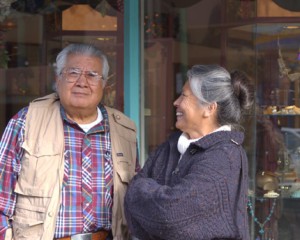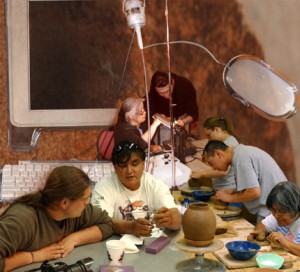Forward, Nang Be Poeh
 We tend to think of technology as a force that dehumanizes, forgetting that technology has been a part of the human experience from its very beginnings. It shaped the thinking and methods that enabled human beings to express themselves and communicate, to sur-vive. In western society, the initial meaning of technology sheds light on the term’s sig-nificance. The Greek technologia was derived from the word techne art and meant a discourse on the arts.
We tend to think of technology as a force that dehumanizes, forgetting that technology has been a part of the human experience from its very beginnings. It shaped the thinking and methods that enabled human beings to express themselves and communicate, to sur-vive. In western society, the initial meaning of technology sheds light on the term’s sig-nificance. The Greek technologia was derived from the word techne art and meant a discourse on the arts.
The Poeh Center and Museum restores technology to it primary place and function. Here, culture forms the heart and spirit of art in a place and through programs; a place of human and cultural dialogue. This idea drives and shapes all that happens within its walls, and, with communications technology, extends beyond into a limitless space where the creativity of native peoples connects with others. The tools—computers, internet, digital records of sound, color, image–capture creativity in our communities and take it to the world.
 Technology facilitates the unique character of the Poeh Center as a place where we might gain some insight to the subtleties and significance of culture in community, social, and human development. While some might consider technology and culture as mutually ex-clusive forces, Poeh shows how they may indeed be complementary and enhancing.
Technology facilitates the unique character of the Poeh Center as a place where we might gain some insight to the subtleties and significance of culture in community, social, and human development. While some might consider technology and culture as mutually ex-clusive forces, Poeh shows how they may indeed be complementary and enhancing.
In the scheme of Pueblo artistry, technology becomes a tool that helps us to understand the meaning of space, place, color, sound—even silence—as the repertoire of life. Tech-nology has been fashioned to “fit” and not fragment. As part of a continuum of change and continuity, Pueblos have con-stantly dealt with new elements whether wrought by force of nature or human interven-tions. Accommodation to an otherwise unfamiliar ide-ology, institution, language, and machine has shaped Native American life. We may mistake the changing form of cultural expression, but at the deep content level, cultural integrity remains steadfast. Thus technol-ogy comes as but another aspect of native com-munities to deal with shifting realities, without sacrificing the core of cultural being.
 Technology takes us to another place, where we sense the significance of the mind‘s eye though sound and image that these devices enable. You hear the past through voices, conversations carried by wind and song intermingled with recordings and visual images. With technology “art” tells its own story through the voices of those who fashioned new forms from ancient clay, and whose images call forth the hidden spirit within stone and give it life. Lyric beauty of language sounds embeds meanings we may not fully know of its words. Just hearing its rhythm and tonality creates an aural color, and transports us to places and spaces linked to millennia long life.
Technology takes us to another place, where we sense the significance of the mind‘s eye though sound and image that these devices enable. You hear the past through voices, conversations carried by wind and song intermingled with recordings and visual images. With technology “art” tells its own story through the voices of those who fashioned new forms from ancient clay, and whose images call forth the hidden spirit within stone and give it life. Lyric beauty of language sounds embeds meanings we may not fully know of its words. Just hearing its rhythm and tonality creates an aural color, and transports us to places and spaces linked to millennia long life.
Technology joins native peoples across the globe in a new, still forming, era of reformu-lation and community building. It is the modern metaphor for ancient networks, path-ways, and trails that connected our ancient peoples across continents. They carried trade goods, shared ideas, and joined far-flung civilizations in a flow of tradition that continues to this day. That legacy continues, ironically fostered by innova-tions of technology, in a new awakening among native peo-ples everywhere.
Dave Warren
